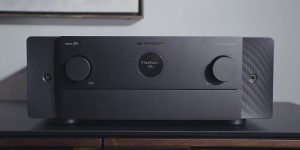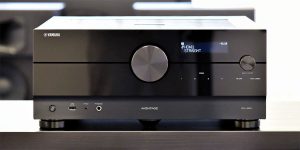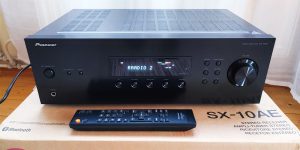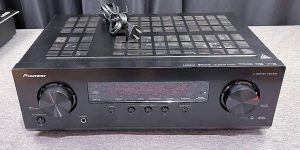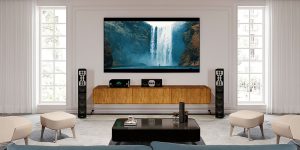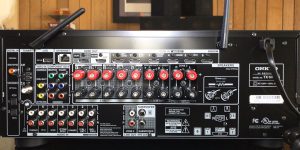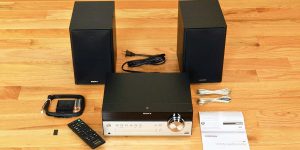The first thing you should think about before buying a receiver is its purpose in your home. If you set your goals correctly, you will not be disappointed with the limited capabilities of a budget model. On the contrary, you will invest more in the system and won’t consider upgrading it for a very long time.
This guide has been developed to help you choose the best AV receiver for your needs. I have selected the top-rated home theater receivers in different categories, from cheap to very expensive. At the same time, you will get information about what parameters to pay attention to when choosing an AVR. But first, let’s find out how much a good receiver can cost.
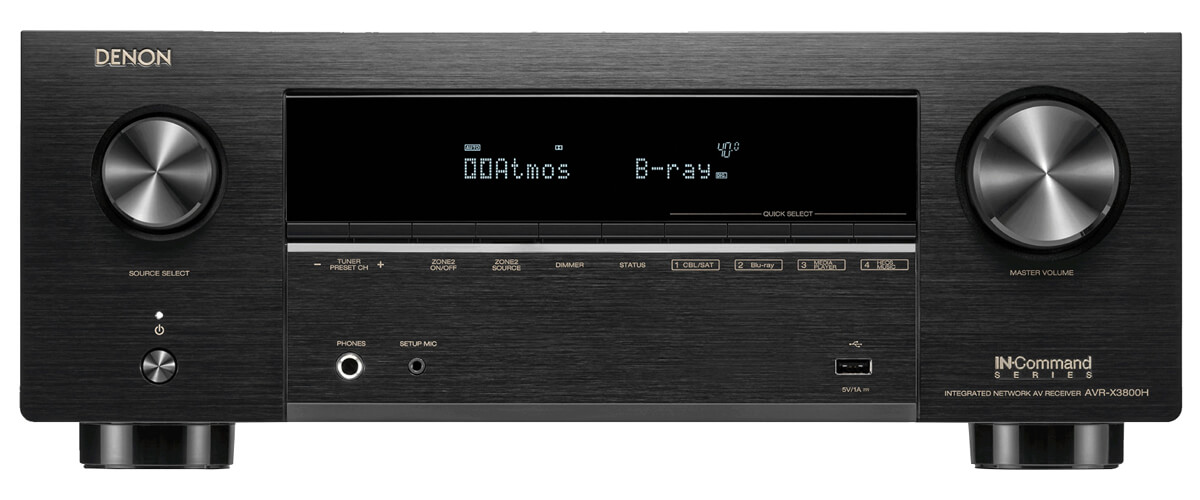
AV receivers comparison table
| Name | Channels | Power output | HDMI in/out | Bluetooth/Wi-Fi | Review |
|---|---|---|---|---|---|
| Denon AVR-X3800H best overal | 9.4 | 105W/8 Ohm, 135W/6 Ohm | 6/3 | yes/yes | Review |
| Onkyo TX-RZ50 alternative pick | 9.2 | 120 W/8 ohms | 7/2 | yes/yes | Review |
| Sony STR-DH790 under $500 | 7.2 | 90W/6 Ohm | 4/1 | yes/no | Review |
| Denon AVR-X1800H under $1000 | 7.1 | 80W/8 Ohm, 120W/6 Ohm | 6/1 | yes/yes | Review |
| Denon AVR-X8500HA premium AVR | 13.2 | 150W/8 Ohm, 190W/6 Ohm | 7/1 | yes/yes | Review |
How much should I spend on an AV receiver
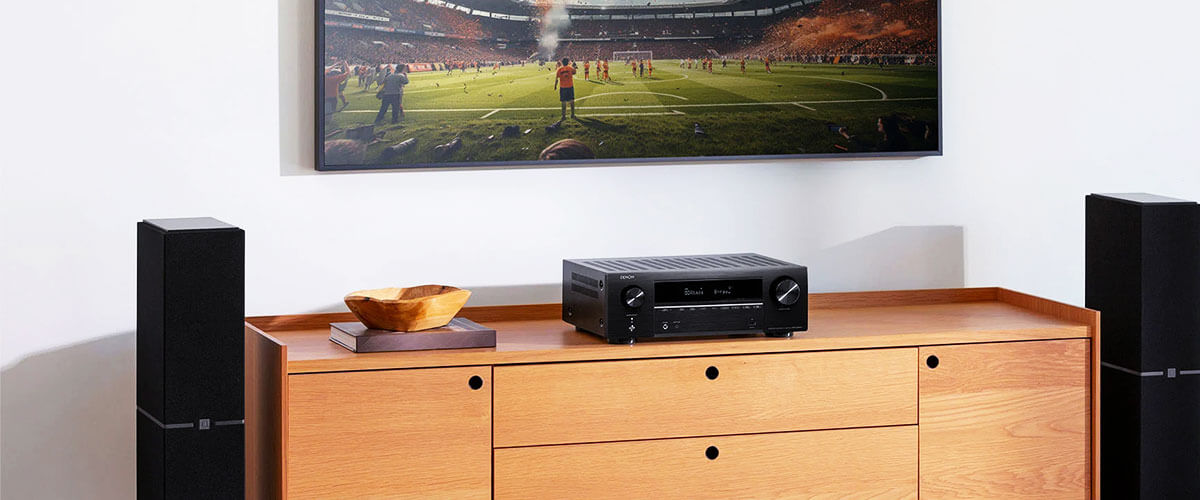
Two of the first questions a person asks themselves before buying an AVR are “How much does a receiver cost?” and “What can you get for the money?”. I would emphasize three main points to answer them:
- Good receivers for home theater do not have to be expensive/the most expensive. This is a myth. If you are a beginner unfamiliar with surround sound at home, a receiver from the mid to budget price category ($500 – $1000) will be quite enough for you. Besides, in this category, models are suitable for small rooms – this is also an important factor (see my detailed guide after the reviews).
- Choose all system components at roughly the same level to make your home theater sound great. What do I mean by that? If you have a set of stereo speakers for around $1000, it’s wise to choose a receiver in roughly the same price segment ($1000 to $2000). In the case when it comes to surround sound audio systems bought at the nearest video store for $300 – $500, the most appropriate would be to buy an entry-level receiver with 5 or 7 channels of amplification (such receivers cost in the range of ($500 – 700).
- Of course, the receiver’s functionality and capabilities in video and audio signal processing and codecs depend on the price. You can also read more about it in the buying guide at the end of the review.
I also recommend you to read our picks in different price segments:
Best Best AV receivers reviews
AV receiver under $500
Sony STR-DH790 – under $500
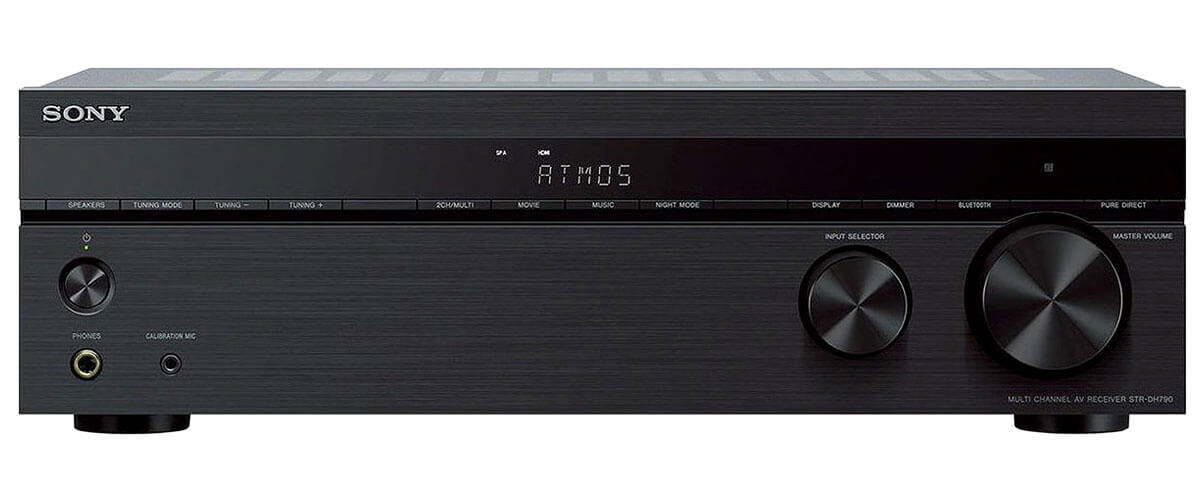
I will start my diverse review with a model that has been one of the most popular since 2018. The whole point is that the Sony STR-DH790 is a 7.2-channel receiver you can afford without considering the family budget. It provides decent sound and has enough features for all its shortcomings (let’s call them compromises in favor of affordability).
It is natural that when it comes to a cheap device, the manufacturer saves on the quality of the construction in the first place. The case is quite soft; try not to squeeze it too much so as not to wrinkle it. The narrow buttons under the LCD are not too convenient and click when pressed. The speaker terminals are spring-loaded and made of cheap plastic, so I wouldn’t unnecessarily yank them. The light weight of 16.6 pounds also speaks to the not-so-high-quality internal components (you’ll see when we review the more expensive Denon AVR-X1800H). But considering when the receiver was released and how much it cost, it’s all tolerable. Just tune in beforehand, and don’t get frustrated.
The manufacturer claimed 145W per channel, and you may say, “Oh! You said there are no cheap, powerful receivers!”. Always look at the figures in parentheses. This rating is for 6 ohms, and the THD is 0.9%. This means that the receiver is monstrously hoarse at high volume, and on average, you will get 50-70W (8 ohms,20 Hz – 20 kHz, 2 ch) for good sound quality. In addition, the receiver overheats with prolonged use because the ventilation is poorly designed. Still, the main advantage of this home audio receiver is that it decodes Dolby Atmos and DTS:X surround sound formats.
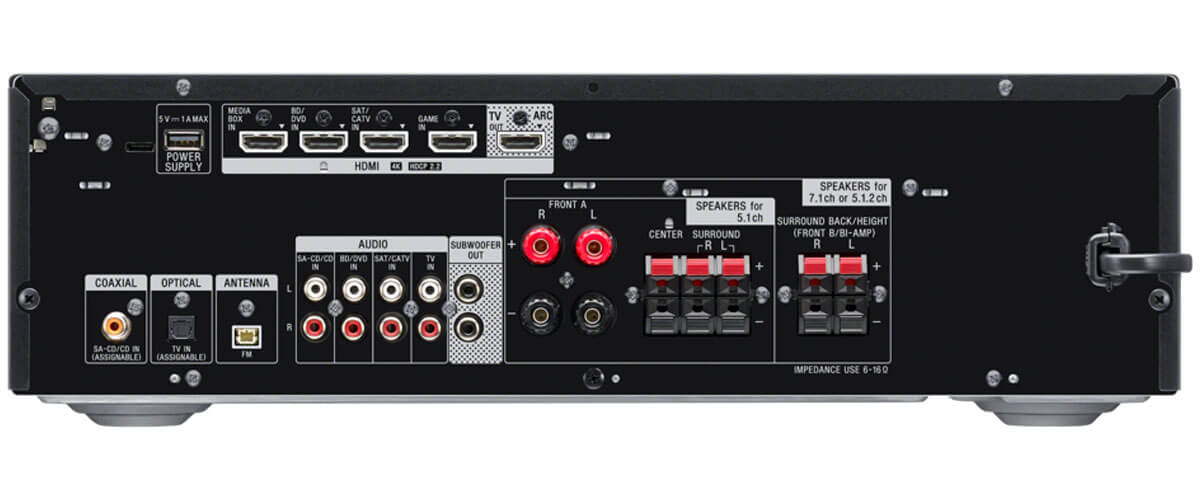
With the Sony STR-DH790, you get 4/1 HDMI ports. This is the smallest number in my selection, but it is normal for a cheap receiver. In addition, we are talking only about 4K/60Hz video, and the range of HDR formats is not much (HDR10, HLG, Dolby Vision). This is not strange because in 2018, they have not yet introduced the 2.1 HDMI version.
You may think that the model in question is not worthy of being on my list, but do not forget that this is the most inexpensive receiver here. What is the most important thing in the center of a home theater? That’s right – sound! And if you set up the system correctly (there is a calibration microphone) and don’t squeeze the volume, you’ll hear a nice, clean sound of STR-DH790. Nothing supernatural, but the overall sound picture pleasantly amazes me. And I’m not surprised that AVR is so popular. I highly recommend using the Bi-amping and Pure Direct functions, greatly improving the sound. There is also the S-Force PRO function. It’s pretty awesome. It simulates surround sound with just 2 front speakers, so you don’t need to bother with surround sound speakers.
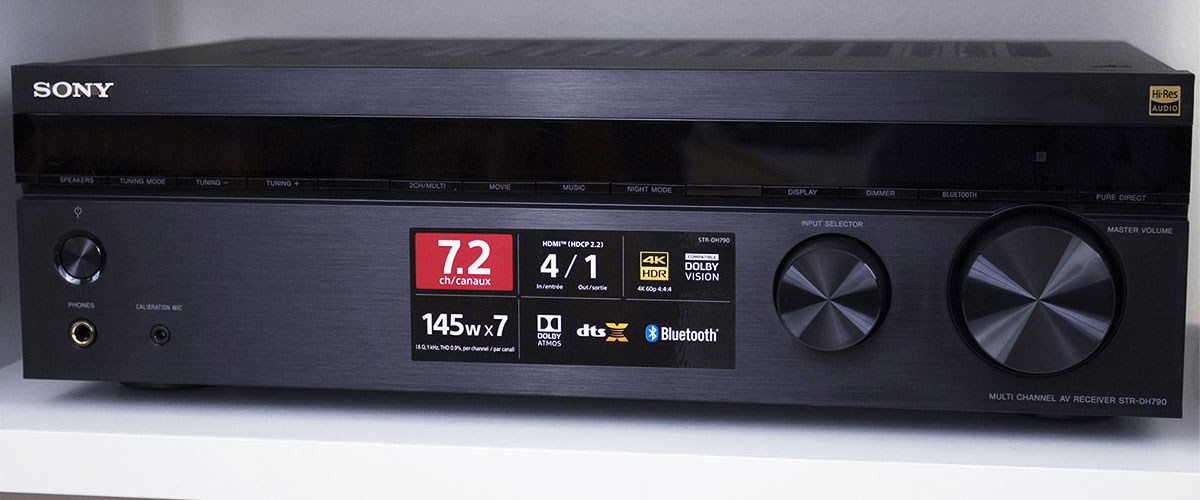
For streaming music lovers, there’s only Bluetooth. Although giving credit, I want to say that it supports the AAC codec and is compatible with Apple devices.
To summarize. So, Sony STR-DH790 is the best AV receiver under $500, which has 7 channels of amplification and Dolby Atmos support. It handles 4K video perfectly, and with the help of Bluetooth, you can pair the receiver with your phone (it works especially well with Apple because it has an AAC codec). The sound is unexpectedly good and clear for its category. There are modes available to enhance the sound. Moreover, the receiver is compatible with speakers with 6 to 16 ohms impedance. In general, you only need to have front speakers (and center) because a function called S-Force PRO simulates surround sound.
However, compromises are what is normal and acceptable in this case. You get poor-quality external and internal components, which means uncertainty in the duration of use. Overheating. Lack of 8K and Wi-Fi. But look, for the money, it’s great.
Key specs
- Channels: 7.2.
- Power output: 145W/6 Ohm.
- HDMI inputs/outputs: 4/1.
- Video functions: 4K/60Hz pass-though.
- Bluetooth/Wi-Fi: yes/no.
- Streaming services: has not.
- Supports: HDMI ARC, HDMI eARC, HDMI CEC, HDCP2.3, HDR10, Dolby Vision.
- Surround sound: DTS-HD Master Audio, DTS:X, Dolby Atmos, Dolby TrueHD.
Pros
- A 7-channel receiver for pennies on the dollar.
- Bi-amping and Pure Direct enhance the soundstage.
- S-Force PRO simulates surround sound with the front speakers.
- Bluetooth supports AAC codec.
- It has good, clear sound, as long as you don’t turn the volume to full.
- Wide compatibility with speakers – from 6 to 16 ohms.
Cons
- The receiver’s build quality is inferior to that of more expensive models.
- Overheats during prolonged use.
- Distortions at maximum volume.
- Supports only 4K video.
- No Wi-Fi.
AV receiver under $1000
Denon AVR-X1800H – under $1000
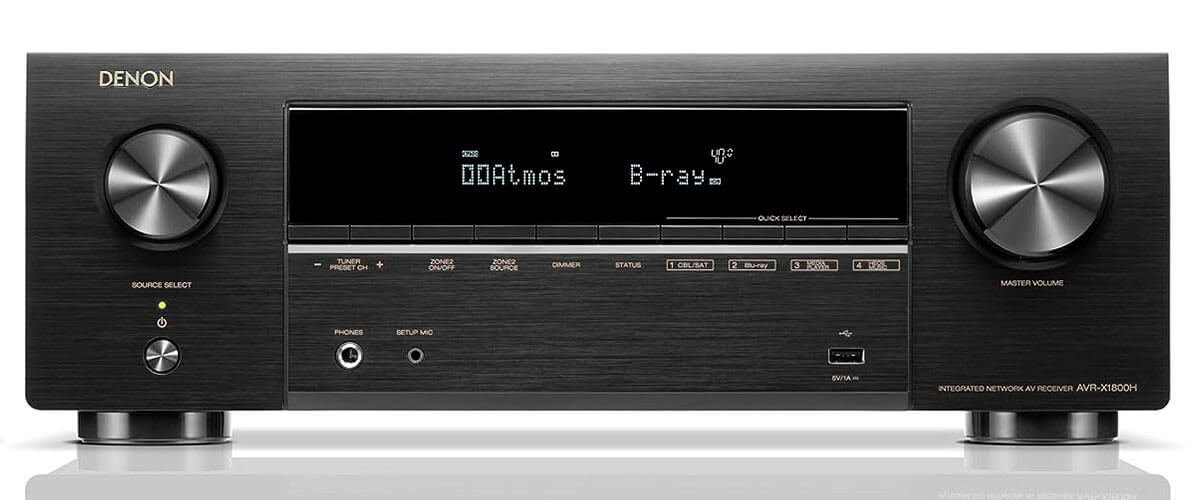
The winner in this category represents my favorite brand, Denon. Model AVR-X1800H was released in 2023, and on the example of this 7-channel receiver, you can see the difference with the budget Sony STR-DH790. This way, you will better understand what you are paying almost 2 times more for.
For the same purpose, we have 19 pounds of net weight. The case isn’t overly rigid but still looks and feels more robust than the STR-DH790. Though it, too, overheats at high power. But this is pretty standard for inexpensive models. The design is standard for Denon; even premium models look exactly the same – classic.
The output power of 80 watts is pretty standard for a 7-channel unit, but the performance of this Denon is much better than the previous Sony. The power is specified for 8 ohms (20 Hz-20 Khz, 0.08% 2ch), and as you can see, its THD allows you to listen to movies at almost maximum without fear of distortion. There’s also a bi-amping function here, but the receiver is only compatible with 6 and 8-ohm speakers.
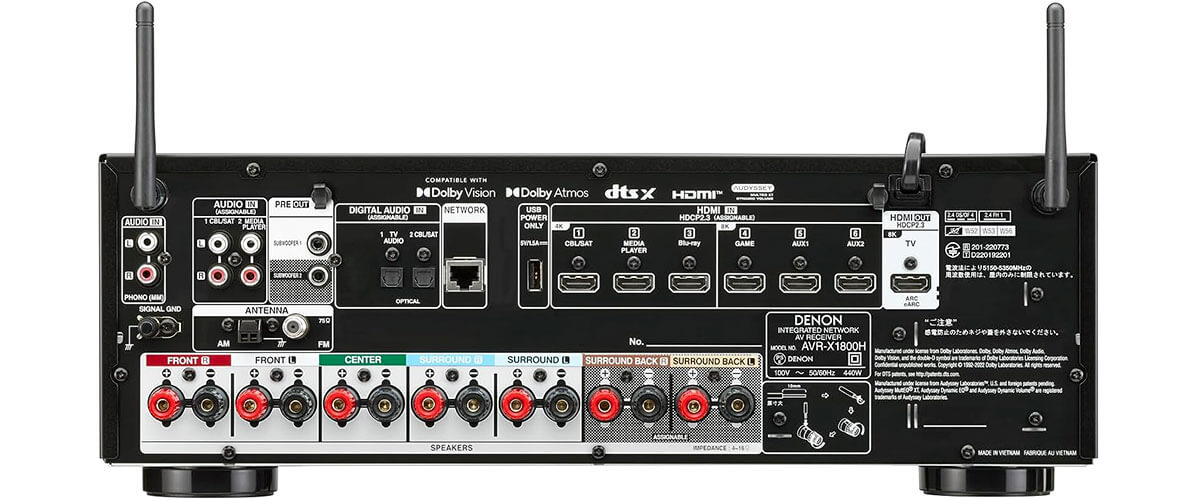
In the video area, the AVR-X1800H surpasses its predecessor in the budget category. It supports 8K video on 3 of its 6 HDMI inputs. This also means you have HDCP 2.3 protection, CEO, and eARC. Note HDMI Diagnostic Mode. If you have problems with audio or video signal transmission, just use it to find the problem and fix it. Isn’t that cool? But yes, it does mean that problems happen. I’ve noticed a slight delay in video when streaming a couple of times, but it’s not critical. There are also delays of about 10 seconds when switching between sources. In principle, these are acceptable flaws; they are not annoying.
Unlike Sony, the AVR-X1800H is an AV receiver for music. In addition to having a phono input for connecting a vinyl player, it works with an impressive number of streaming services, is compatible with voice assistants (Alexa, Google Voice Assistant, Apple HomePod), and has a built-in multi-room HEOS system working via Wi-Fi. The stereo with the Denon is excellent. Maybe not as rich as the more expensive AVR-X3800H or AVR-X8500HA, but with a bright, dynamic shade inherent to the brand. And, as always – don’t expect bass without a subwoofer.
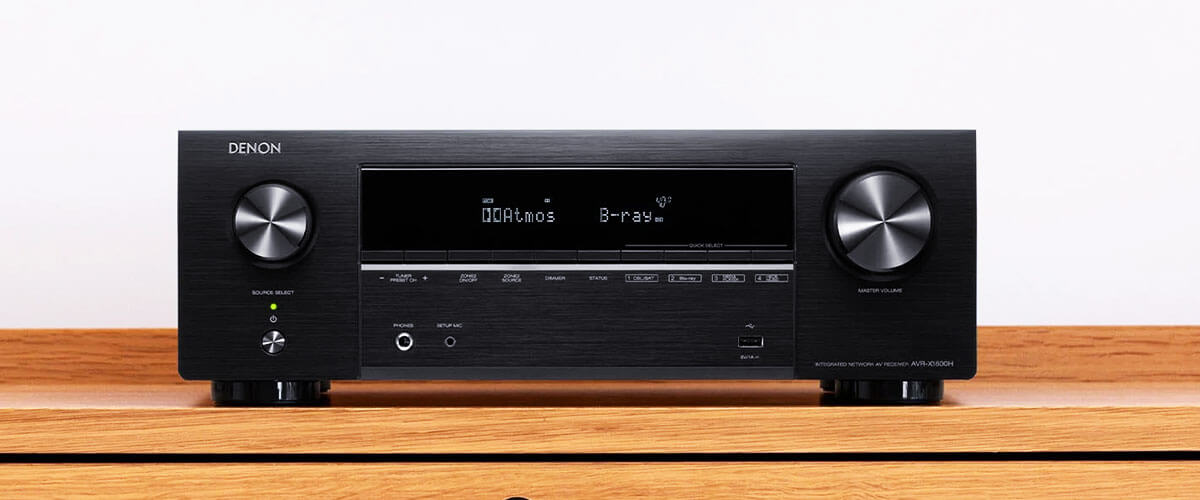
The surround sound is very good. Upper and middle frequencies are expressed very well. Still, since we are talking about the minimum configuration 5.2.2 for Dolby Atmos, the sound picture is vivacious but not as rich in nuances as in the premium segment (this is normal). The AVR-X1800H holds its balance well even in intense action scenes, and in a small studio (about 200 square feet), the sound was dispersed with just the right amount of dispersion. It supports Dolby Atmos Height Virtualization and DTS Virtual:X surround formats, so you don’t have to buy ceiling-mounted speakers. Given the uncomplicated system, imitating the upper channels is very close to full range.
Denon AVR-X1800H is a great AV receiver under $ 1,000. Compared with the budget Sony STR-DH790, its advantages as a 7-channel modern AVR are especially noticeable. This model has a more reliable (though still quite flimsy) design, supports many surround sound formats, including simulation of upper channels, processes 8K video, and the list of wireless features is quite extensive (compatible with streaming services, voice assistants, and has a built-in multi-room HEOS system). If handled properly, you can expect a pretty long lifespan as the brand keeps the brand name throughout. I also chose it over many other models in this category, as its bright, dynamic range and versatility in movies and music make it stand out from the crowd. There are compromises, but they are all quite normal for the price of the AVR-X1800H.
Key specs
- Channels: 7.1.
- Power output: 80W/8 Ohm, 120W/6 Ohm.
- HDMI inputs/outputs: 6/1.
- Video functions: 8K/60Hz, 4K/120Hz pass-through, 1080P/4K to 8K HDMI upscaling.
- Bluetooth/Wi-Fi: yes/yes.
- Streaming services: AirPlay2, TuneIn, Spotify, Pandora, SiriusXM, Amazon Music HD, TIDAL, Deezer, iHeart Radio, Napster, SoundCloud, Mood Mix.
- Supports: HDMI ARC, HDMI eARC, HDMI CEC, HDCP2.3, HDR10, Dolby Vision.
- Surround sound: DTS-HD Master Audio, DTS:X, Dolby Atmos, Dolby TrueHD.
Pros
- THD is better than the Sony STR-DH790; you can use full volume without distortion.
- Unlike the Sony STR-DH790, it supports 8K video on 3 HDMI inputs.
- More HDMI Ports.
- HDMI Diagnostic Mode helps you find and fix the error.
- Supports a large number of wireless technologies.
- Clear, bright, dynamic sound in stereo and movie.
- Broadcast audio to 2 zones.
Cons
- Heats up when working for long periods of time.
- There were slight delays when streaming 8K video and switching sources.
- Weak bass.
AV receivers under $2000
Denon AVR-X3800H – best overall

I have two models that can safely compete in this category because they have very similar features and costs. But my favorite was, is, and will be Denon because it combines the most reasonable price/quality ratio among all brands. In this review, the AVR-X3800H has a higher price tag than the Onkyo TX-RZ50, but it becomes the best AVR in the under $2000 category.
Externally, it’s impossible to distinguish the AVR-X3800H from the AVR-X1800H previously featured in the review. That’s the company’s saying that they don’t pay much attention to design. But it means you don’t pay for a beautiful appearance, but only for what’s under the case. Remember what I said about the weight value? Well, here we have 27.6 pounds, which means that there are not only two additional amplifiers under the hood (we’re dealing with a 9-channel receiver) but also a better processor and all the other components. The front panel is not metal, but the case looks solid to the touch. And, unlike AVR-X1800H, it doesn’t overheat under heavy loads.
So, the main advantage of AVR-X3800H is that you can expand your system up to 11 channels with an additional amplifier. You can only provide sound to 2 zones. The receiver’s output power is 105 watts, and here it loses out to the Onkyo TX-RZ50, which has 120 watts, but with the same bracing data into 8 ohms (20Hz – 20kHz, 0.08%, 2ch). But Denon’s engineers are no fools and gave their receiver a bass advantage by equipping it with 4 separate pre-outputs for subwoofers. It makes a difference if you like to feel the sound on your skin.
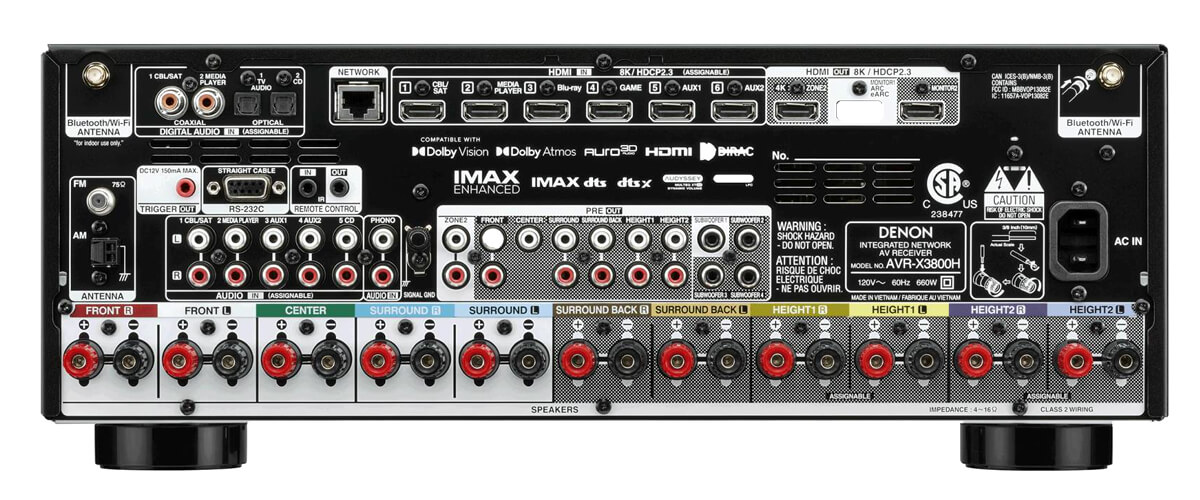
As you’ve already realized, the year of release matters, and in this 2022 receiver, all 6/3 HDMI ports are version 2.1, meaning they work with 8K video. You can forget about upgrading for years to come (and not just for that reason). You can even stream 4K video to a second zone. Considering all the features you need for gaming, we have a great example of modernity in the mid-range segment.
In addition to the standard DTS:X and Dolby Atmos, you can watch movies with IMAX Enhanced Sound, 360 Reality Audio, and Auro 3D. AVR-X3800H, of course, is not a monster among receivers, but watching the movie “Han Solo” with its help made me absolutely delighted. In the train robbery scene, when Woody Harrelson was shot with guns, and he took cover behind a metal cover, I dodged a ricochet at one point with my movie-watching experience. For me, this is enough to give the receiver a high mark. Separately, it is worth saying about the Audyssey calibration system. It is rightly considered the most adaptive and simple of the “native”, even for beginners. It does not require additional intervention if you are unfamiliar with the nuances.
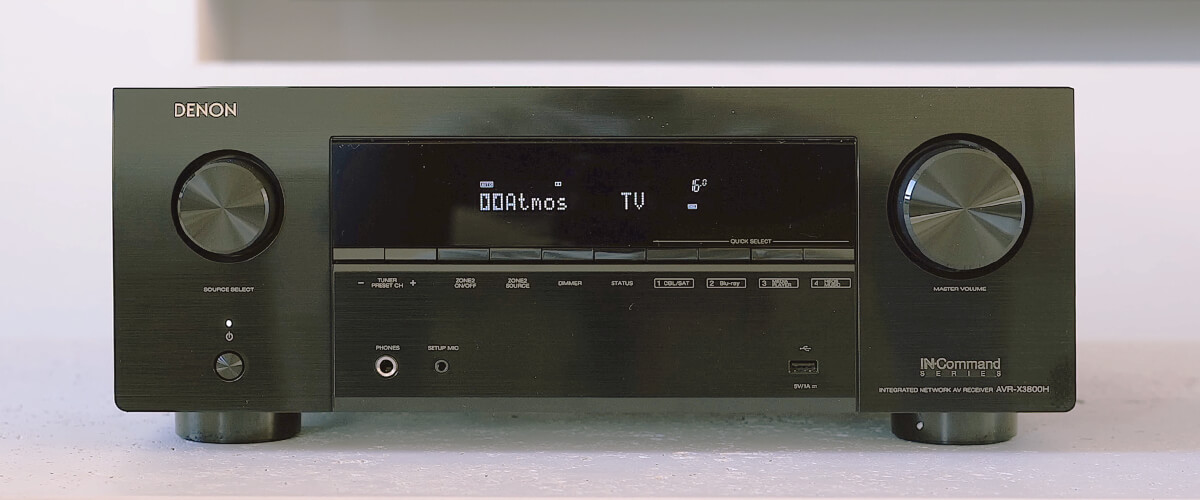
Why do I love Denon? Because they are versatile. With the AVR-X3800H, listening to music is as much fun as watching a movie. In addition to the vinyl I adore, which gets the warmth it needs (there’s a phono stage), the wireless capabilities are impressive. Just look at the list of streaming services the receiver works with, and rest assured, you’ll always have something to listen to. The HEOS system developed by the company is one of my favorites; it is coherent and stable in any segment. There are some small problems with the work of applications, but I think the company will fix them soon (simultaneous use of Denon and HEOS applications slows down).
Denon AVR-X3800H is a great example of a balanced quality-price ratio. It sounds on par with more expensive models, offering you detailed, high-quality sound with rich detail. And even if you don’t have the highest power output, you won’t lose out as you can add bass thanks to the 4 sub outputs. The internal components are of good quality, and the features work as the manufacturer claims. It supports many modern video and surround sound formats, including 8K, Dolby Atmos, IMAX Enhanced, and Auro 3D. It’s compatible with Android and iOS and has the same wireless signal quality. A great workhorse that will work out every penny invested in it.
Key specs
- Channels: 9.4.
- Power output: 105W/8 Ohm, 135W/6 Ohm.
- HDMI inputs/outputs: 6/3.
- Video functions: 8K/60Hz, 4K/120Hz pass-though, upscaling up to 8K.
- Bluetooth/Wi-Fi: yes/yes.
- Streaming services: AirPlay 2, Spotify, TuneIn, Deezer, Tidal, Netflix, Amazon Prime.
- Supports: HDMI ARC, HDMI eARC, HDMI CEC, HDCP2.3, HDR10+, Dolby Vision.
- Surround sound: DTS:X, DTS Neural:X, DTS Virtual:X, Dolby Atmos, DTS HD Master, Dolby TrueHD, Dolby Atmos Height Virtualization, Dolby Atmos Music, Auro 3D.
Pros
- The system can be expanded to 11 channels with 4 subwoofers.
- For gamers, all the necessary functions are provided.
- Wireless capabilities are not limited and demonstrate stable operation.
- The Audyssey calibration system is simple and balanced, even for beginners.
- Balanced price/performance ratio.
Cons
- Power is a bit low for a large system (but can be compensated by 4 subs).
- Slow performance when using Denon and HEOS apps at the same time.
Onkyo TX-RZ50 – alternative pick
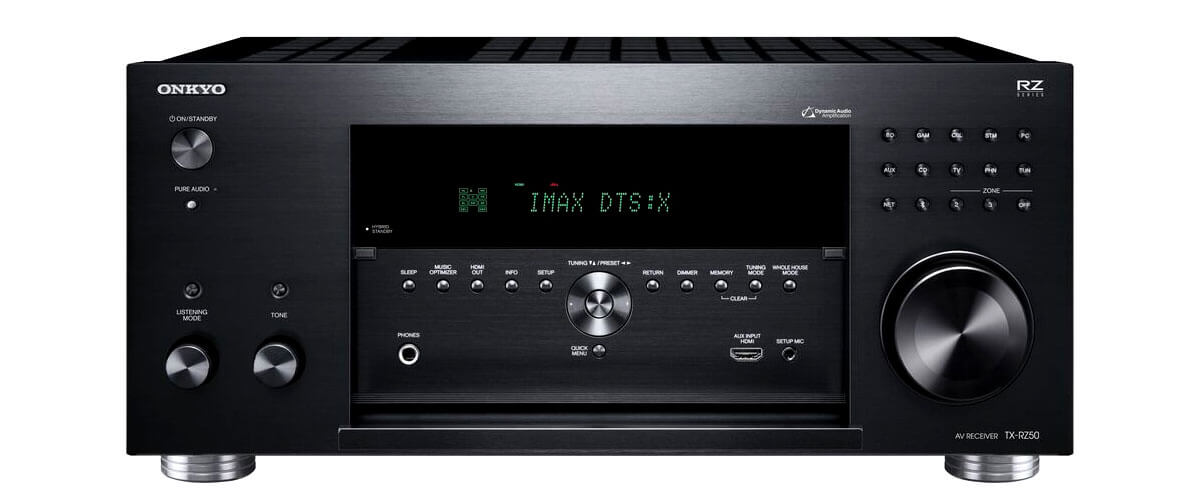
An alternative, less expensive model in this category is the Onkyo TX-RZ50 9kas you have already guessed), released in 2021. It costs a little less because the brand produces receivers with many features, but their quality is still inferior to the more prestigious Denon. That’s why the receiver will suit those who do not believe in the company’s name but only want to get everything in one package.
So, the TX-RZ50 weighs an impressive 30.9 pounds, but it’s just bigger than the Denon AVR-X3800H. The control buttons are on the side but very small and awkward (I don’t find them comfortable at all, haha). But I can already “see” how dirt and grease from hands get into the slots. And it’s not solid somehow. In general, nothing special can not be singled out. Normal design, good LCD, simple control.
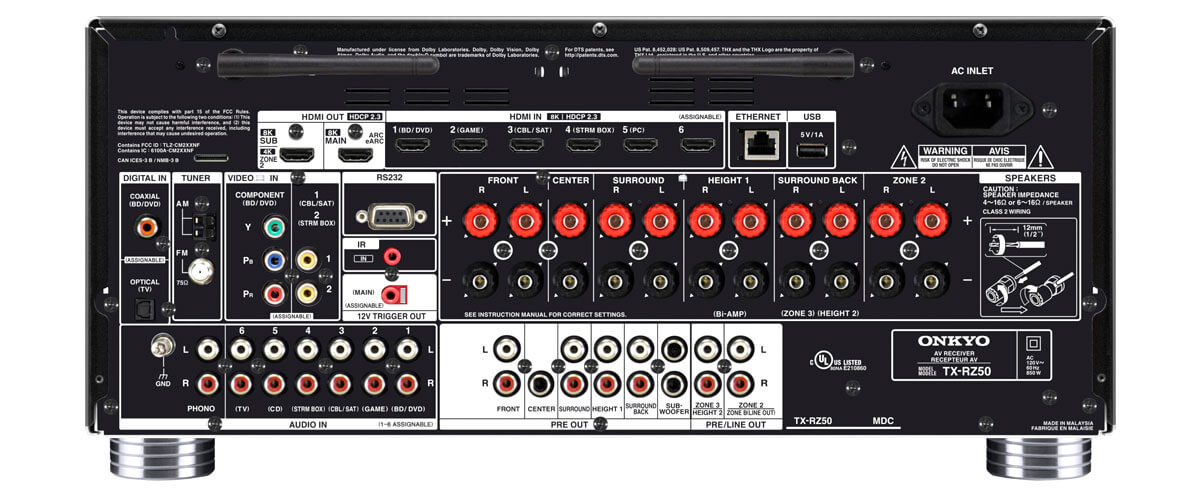
There is more power (as I already mentioned); it is 120 W (8 Ohm, 20 Hz – 20 kHz, 0.08% THD, 2 ch), but taking into account the possibility of adding only 2 subs, the overall sound picture is not better than that of AVR-X3800H. In general, if we talk about sound, Denon has it fat and dense; you feel like you’re bathing in it. TX-RZ50 has a simple, flat, clean, and balanced sound. Of the surround sound formats, only Dolby Atmos and DTS:X (with IMAX Enhanced added) are supported. Not that it’s bad (enough), but to be a 9-channel receiver with expandable up to 11 channels (like AVR-X3800H) and not have Auro 3D support today is somehow not respectable. But you pay less, so get the difference.
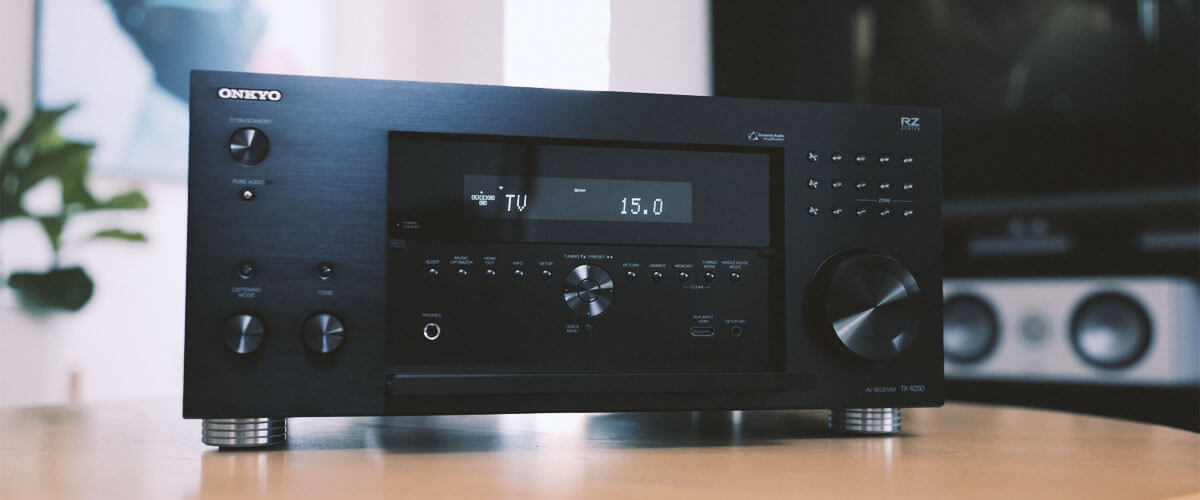
To make it easier to understand what we are dealing with, I’ll just highlight the main advantages and disadvantages of Onkyo TX-RZ50 (including in comparison with AVR-X3800H) from those I haven’t mentioned yet. But I will say right off the bat that they are identical in video capabilities.
Pros:
- Different HDMI configuration (1 more input);.
- Audio distribution into 3 zones;.
- DTS Play-Fi Ready and Bluetooth with support for AAC and aptX HD codecs are considered more stable than the standard versions;.
- The receiver is THX Certified Select, emphasizing its high-end class.
Cons:
- The receiver is compatible with Hey Google or Alexa voice assistants, but you must purchase a separate device. That’s an additional expense.
Onkyo TX-RZ50 is one of the best AV receivers, with 9 channels of amplification and 11.2 channel processing in its segment. It is a good alternative to AVR-X3800H. For rather modest money, you get the functionality of more expensive models. And if you are not too picky about details and sound saturation, you will be quite satisfied with signal transmission quality.
Yes, it is massive, not the most convenient to operate, does not support all modern surround sound formats (no Auro 3D), and is inferior to Denon AVR-X3800H in terms of sound picture. To integrate a smart home system, you must buy a special device. But it does have advantages, such as more advanced versions of Wi-Fi and Bluetooth (supports AAC and aptX HD codecs, audio for 3 zones, and THX Certified Select title. It’s your choice, but it’s not at the top of my list (clarification).
Key specs
- Channels: 9.2.
- Power output: 120W/8 Ohm, 250W/6 Ohm.
- HDMI inputs/outputs: 7/2.
- Video functions: 8K/60Hz, 4K/120Hz, 4K/60Hz pass-through, video upconversion (up to 1080p and 8K) for analog and HDMI sources.
- Bluetooth/Wi-Fi: yes/yes.
- Streaming services: AirPlay2, Deezer, Tidal, Pandora, Spotify, Amazon Music HD, TuneIn.
- Supports: HDMI ARC, HDMI eARC, HDMI CEC, HDCP2.3, HDR10, HDR10+, Dolby Vision.
- Surround sound: DTS HD Master, DTS Neural:X, Dolby TrueHD, Dolby Surround, Dolby Digital Plus, Dolby Atmos Height Virtualization, Dolby Atmos, IMAX Enhanced.
Pros
- Multi-room function for 3 zones.
- DTS Play-Fi Ready and Bluetooth for AAC and aptX HD codecs are considered more stable than the standard versions.
- THX Certified Select means a high rating for sound quality.
Cons
- You can only connect 2 subwoofers, not 4 like the Denon AVR-X3800H.
- The overall soundstage is inferior to the Denon AVR-X3800H. It is flatter, more ordinary, with no clear advantages.
- There is no support for the Auro 3D surround sound format.
- You must buy a special device to work with Hey Google or Alexa.
Premium AV receivers
Denon AVR-X8500HA – premium AVR
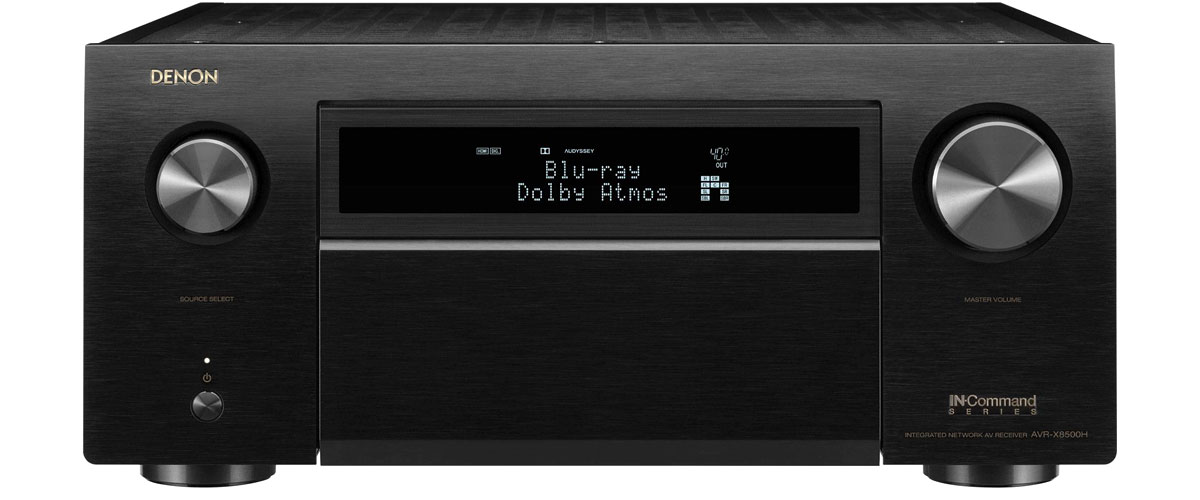
Dear friends, the end of my review has arrived. Ultimately, I am thrilled to present you with the best home theater receiver in the premium segment – Denon AVR-X8500HA. I think you have already felt my love for the brand’s devices, and you know that this is the third representative of the company in this selection. But believe me, I base my analysis not only on my subjective opinion (but I don’t hesitate to express it).
So, in front of us, we have a monster with 150W of power (8 ohms, 20Hz – 20kHz, 0.05% 2ch). The AVR-X8500HA has 13.2 channels of amplification, but you can add another external amplifier and get 15 channels. This receiver requires a professional approach, special acoustics, comfortable chairs, and, of course, popcorn because if you do it right, you might even have more fun than in a public theater. Everything in it gives away the feeling of belonging to luxury, except for the design. I like it; no surprises. The external controls are hidden under a metal cover, moving so smoothly that I can adjust the sound extremely nuanced. You’ll even have gold-plated RCA connectors. The AVR weighs 52 pounds; I don’t think you’ll need to fix it anytime. It’s like a reliable Mercedes. You bought it once and passed it on to your grandson.
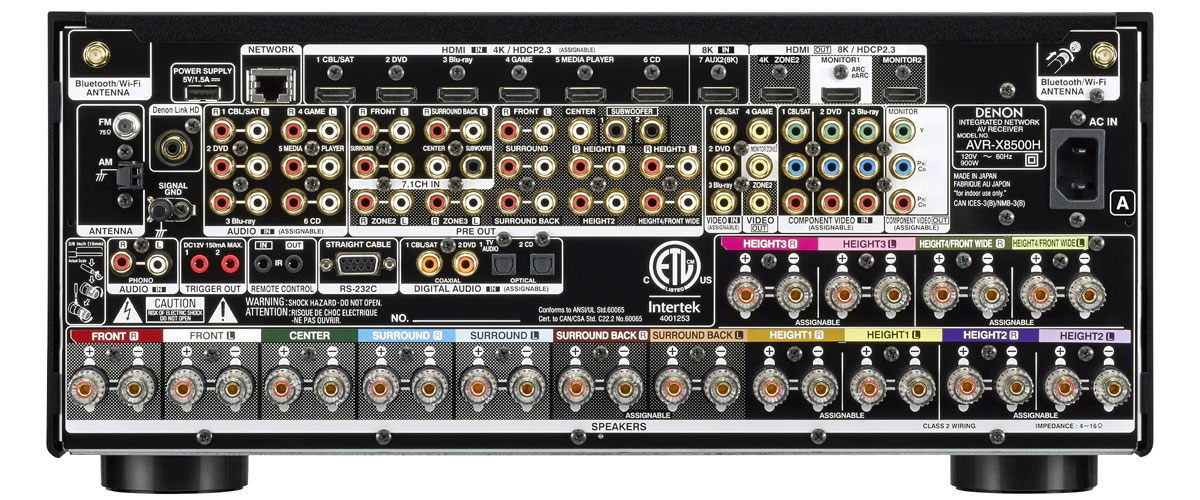
There’s no limit to the number of connections. It’s true. As much equipment as I have in my studio, believe me, I connected everything I wanted. Gamers, movie buffs, and music lovers will be delighted. But still, the year of release has played its cruel joke, and the Denon AVR-X8500HA has only 1 HDMI connector with version 2.1.
I have already said that listening to vinyl with Denon is a special pleasure. The records from the ’70s, which I have plenty of, sound amazing (of course, I have a great turntable too). Fleetwood Mac, Townes Van Zandt, and Black Sabbath sounded like I was sitting right there with the performers when they were recorded. I could feel the hand touching the strings of the guitar… If you decide to buy AVR-X8500HA but have not yet joined vinyl – I highly recommend it (don’t skimp on acoustics). The digital stereo also delighted me, as I did not catch a single lag, failure, or delay. Everything works lightning fast.
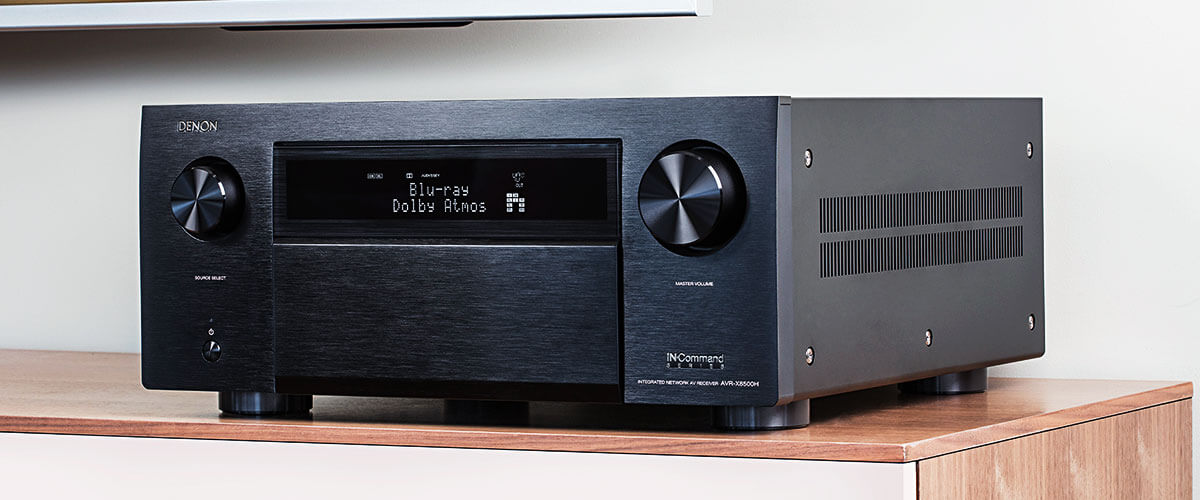
The movie? Oh. That’s a delight. I love nuance, so in addition to Avatar Part II, I chose the unique (in my opinion) film A Quiet Place. If, in the first case, there was a lot of action, and I was periodically squeezed into the chair or knocked out of it (the sound literally throws you following what is happening on the screen), then in the second case, I felt the sound in the hairs on the skin of my hands. Amazing. Fantastic. Unrivaled. These are the words I would like to say to the AVR-X8500HA. The movie, which has almost no dialogue, made me experience every second and listen to every nuance. The bar has been set.
Of course, expressing your excitement about something that’s done intelligently is easy. Premiumization is felt in every detail of the Denon AVR-X8500HA, whether the design or the sound the receiver produces. It’s super powerful. The sound is clear at the highest volume (two dual-core Griffin Line DSPs, 4-channel DDR3 memory, and 32-bit format audiophile DACs AKM AK4490EQ Velvet Sound from Asahi Kasei). This model can handle all genres of music, any movie, or even a game. The picture quality is amazing, and even 8K upscaling works perfectly). Everything in the receiver is top-notch and will serve for many years, like a good car that a grandfather passes on to his grandson as an inheritance.
The only downside is the year of the intake. In 2021, they were still not overly implementing version 2.1 for HDMI, and it had issues, so only 1 input was equipped with it. In my opinion – this is not a problem because today, there is very little content in 8K resolution, and the average user is unlikely to notice a significant difference with 4K video. In general, my emotions are the answer to all your questions.
Key specs
- Channels: 13.2.
- Power output: 150W/8 Ohm, 190W/6 Ohm.
- HDMI inputs/outputs: 7/1.
- Video functions: 8K/60Hz, 4K/120Hz pass-though, upscaling up to 8K.
- Bluetooth/Wi-Fi: yes/yes.
- Streaming services: AirPlay 2, Spotify, TuneIn, Deezer, Tidal, Netflix, Amazon Prime.
- Supports: HDMI ARC, HDMI eARC, HDMI CEC, HDCP2.3, HDR10+, Dolby Vision.
- Surround sound: DTS:X, DTS Neural:X, DTS Virtual:X, Dolby Atmos, DTS HD Master, Dolby TrueHD, Dolby Atmos Height Virtualization, Dolby Atmos Music, Auro 3D, IMAX Enhanced.
Pros
- The system can serve as a professional home theater, offering 13.2 channels of amplification and 15.2 channels of processing.
- The highest rated power is 150W/8 ohms.
- High build quality is felt in every detail (smooth adjustment of settings, volume, and gold-plated RCA connectors).
- A huge number of wired and wireless connections.
- Works great in surround sound, with vinyl and digital resources, and has all the features for gamers – versatile and will last for years.
- Under the hood, the content is terrific.
- 8K upscaling works beautifully.
Cons
- Only 1 HDMI input is version 2.1 and is for 8K video.
What to look for when choosing an AV receiver
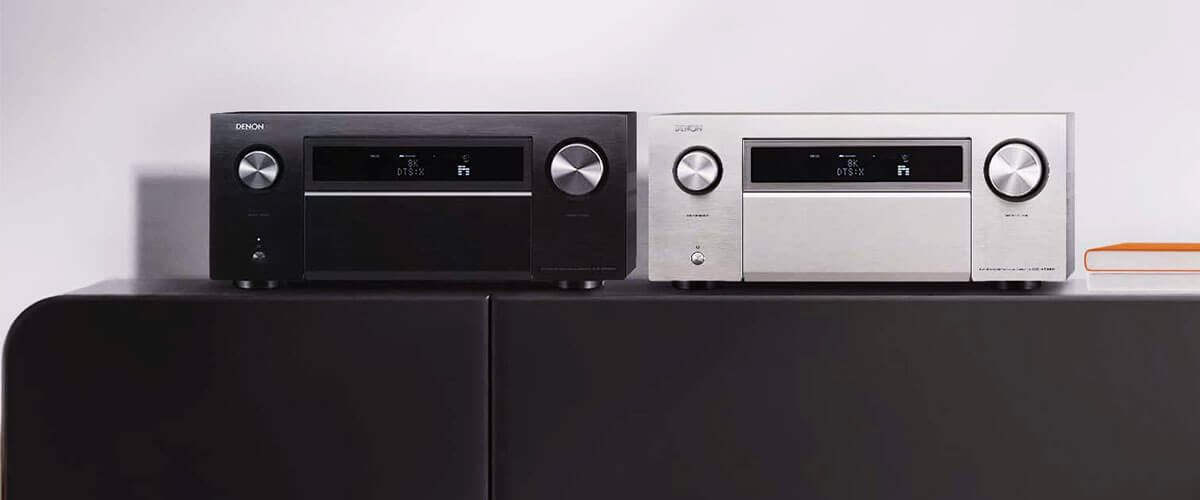
Power output
The value of receiver power is overly exaggerated. It depends on what room (size) your system is in, what speakers you selected, and what THD rating is next to the specified power rating. Let me try to explain.
The human ear cannot recognize the difference in volume, say 70 and 100 watts. But you can perfectly hear the noise your system is making at maximum volume. Choose receivers with a THD of 0.08% or lower (even in the budget segment, modern models show excellent results). Also, the receiver’s power and impedance rating should match the speakers. This is important because you will hear a clearer sound, and the speakers will not be damaged over time.
In terms of room size, a room of 150 to 300 ft² is wonderfully filled with balanced sound at 50 to 100 watts of power. More power at maximum will turn the system’s sound into a medley. Sound should spread out, not accumulate around you. But of course, if you want the walls of your house to shake with power and you have a large room, you should consider more expensive models with 140-150 watts of power.
Channel configuration
The number of channels is a determining factor when choosing a home theater. If your budget allows, I recommend choosing more channels because this way, you get a more detailed sound picture, where the sound layers are distributed as intended by the movie’s creator. The experience is guaranteed. Besides, you don’t have to connect a full-fledged speaker immediately; start with 5 speakers. Over time, you can buy the remaining speakers if you can’t afford an expensive set at once.
Briefly, 2.1 stereo receivers are for music only (but they also improve the experience of a regular TV). The minimum configuration for surround sound is 5.1. And with 5.1.2 (7-channel receiver), you can watch content with Dolby Atmos sound.
But remember that the power and number of channels are related directly to the size of the room where you install the theater. You don’t want to get a small system for a large room or more channels for a small room.
I recommend you to look at our reviews, where the models are selected by the number of channels:
Connectivity options
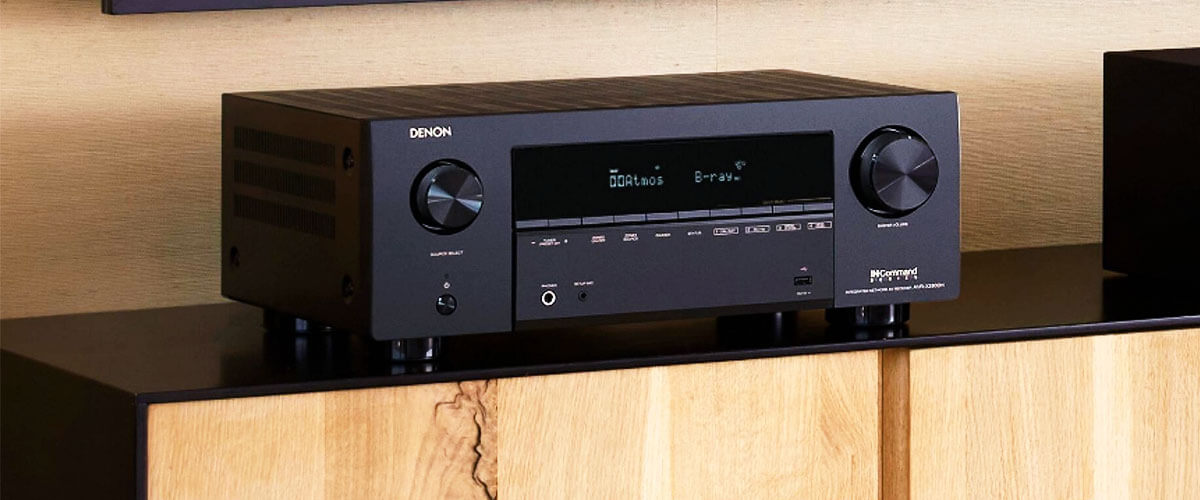
It is also extremely important to consider what you plan to connect to your system. The main connectors in the case of a multi-channel theater are HDMI ports, through which audio and video signals are fed from the source to the receiver and then to the receiver (TV or projector). The more inputs, the better; you won’t have to change the source whenever you connect them all simultaneously. But pay attention to the version. Version 2.1 has been available in receivers since 2021 and determines your receiver’s ability to transmit 8K video resolution. It also has other advantages.
Component and composite inputs allow you to connect older devices. The phono input is designed for a vinyl turntable. The pre-outputs allow you to connect more subs or an additional amplifier.
Correspondingly, Bluetooth and Wi-Fi options greatly expand your ability to connect with wireless devices.
Audio formats and decoding capabilities
The user can enjoy surround sound from 5 channels of amplification when watching movies (in my review, the models start from 7 channels). These receivers support the basic surround sound formats DTS HD Master and Dolby TrueHD. All models with 7 channels and above support them, but the advantage is that with a minimum 5.1.2 configuration, you can count on Dolby Atmos and DTS:X sound. Today, more and more content is being released with these immersive formats, and you can install ceiling speakers (Dolby Atmos) or not (DTS:X), but the soundscape is richer with them. In the case of Dolby Atmos, the sound comes from above if objects are supposed to be moving in the movie.
Starting with a 9-channel system, you can also get Auro-3D and other sound chips (see the receiver specification; not all models support it). All of these surround sound formats provide an unforgettable experience and are the most popular today.
Check out our selection:
Video support
Well, sound isn’t the only thing that matters in a movie, don’t you agree? The picture you see is half of the success, no exaggeration. Today, all receivers can handle 4K/60Hz video resolution. But better yet, look for 4K/120Hz in the spec sheet. That’s not the limit. The maximum for 2024 is 8K/60Hz video resolution; not all AVRs can handle it.
Does it really matter? No. Modern streaming services and Blu-ray disks don’t release too much 8K content, and you’ll need a TV that supports it. 4K is quite sufficient. What is more important is what HDR formats the receiver supports. This depends on the quality of light transmission, contrast, color, and, as a result – a better picture. In the specification, you should pay attention to the presence of HDR10, HDR10+, HLG, and Dolby Vision.
For a better understanding of the topic, check out our review:
Compatibility with smart home systems
In addition, consider integrating your home theater into a smart home system. Today, many models are compatible with Sonos and other wireless sound systems throughout your home. The more expensive the receiver, the more streaming services, voice assistants, and its own multi-room technologies are built in (CEOS for Denon and Marantz, MusicCast for Yamaha, and other models are compatible with ChromeCast)/ Less expensive receivers do not have this. Still, you can connect to them via Wi-Fi or at least Bluetooth.
Also, the more channels a receiver has, the more likely they can be divided into multiple zones (as indicated in the spec sheet). This means you may not have to buy a receiver for each room separately but rather use one AVR as a central one.
Check out our reviews:
We are supported by our audience. When you purchase through links on our site, we may earn an affiliate commission at no extra cost to you.
Our newsletter
* We will never send you spam or share your email with third parties

![Best Budget Receivers [Reviewed and Tested]](https://thetechholics.com/wp-content/uploads/2023/10/best-budget-av-receiver-300x150.jpg)
![Best 9-Channels AV Receivers [Reviewed and Tested]](https://thetechholics.com/wp-content/uploads/2023/10/best-9-2-receiver-300x150.jpg)

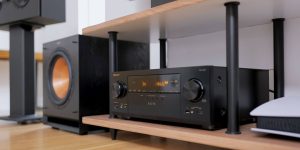
![Pioneer vs Denon Receivers [Top Models Compared and Tested]](https://thetechholics.com/wp-content/uploads/2023/10/denon-vs-pioneer-review-300x150.jpg)
